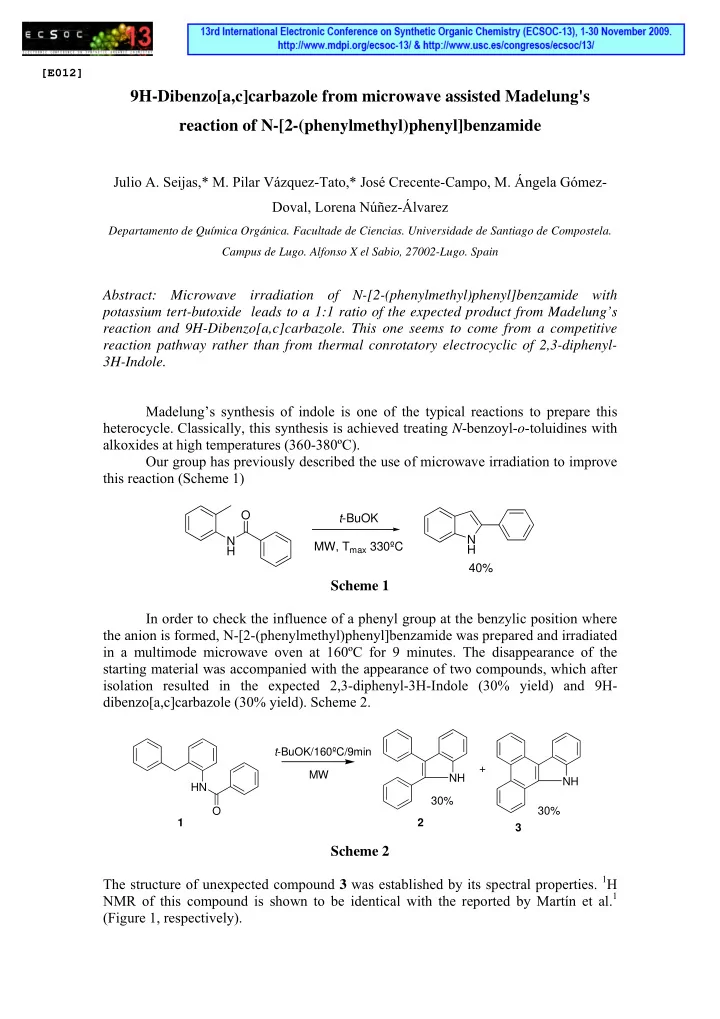

[E012] 9H-Dibenzo[a,c]carbazole from microwave assisted Madelung's reaction of N-[2-(phenylmethyl)phenyl]benzamide Julio A. Seijas,* M. Pilar Vázquez-Tato,* José Crecente-Campo, M. Ángela Gómez- Doval, Lorena Núñez-Álvarez Departamento de Química Orgánica. Facultade de Ciencias. Universidade de Santiago de Compostela. Campus de Lugo. Alfonso X el Sabio, 27002-Lugo. Spain Abstract: Microwave irradiation of N-[2-(phenylmethyl)phenyl]benzamide with potassium tert-butoxide leads to a 1:1 ratio of the expected product from Madelung’s reaction and 9H-Dibenzo[a,c]carbazole. This one seems to come from a competitive reaction pathway rather than from thermal conrotatory electrocyclic of 2,3-diphenyl- 3H-Indole. Madelung’s synthesis of indole is one of the typical reactions to prepare this heterocycle. Classically, this synthesis is achieved treating N -benzoyl- o -toluidines with alkoxides at high temperatures (360-380ºC). Our group has previously described the use of microwave irradiation to improve this reaction (Scheme 1) O t -BuOK N N MW, T max 330ºC H H 40% Scheme 1 In order to check the influence of a phenyl group at the benzylic position where the anion is formed, N-[2-(phenylmethyl)phenyl]benzamide was prepared and irradiated in a multimode microwave oven at 160ºC for 9 minutes. The disappearance of the starting material was accompanied with the appearance of two compounds, which after isolation resulted in the expected 2,3-diphenyl-3H-Indole (30% yield) and 9H- dibenzo[a,c]carbazole (30% yield). Scheme 2. t -BuOK/160ºC/9min + MW NH NH HN 30% O 30% 1 2 3 Scheme 2 The structure of unexpected compound 3 was established by its spectral properties. 1 H NMR of this compound is shown to be identical with the reported by Martín et al. 1 (Figure 1, respectively).
Figure 1 . 1 H NMR of 3 obtained by microwave irradiation of 1 . The formation of the dibenzocarbazole nucleus could be attributed to a thermal electrocyclic conrotatory cyclization (Scheme 3). π 6 s/Thermal H [O] H electrocyclic conrotatory N N N H H H 2 3 Scheme 3 However, when compound 2 was irradiated in the presence of potassium tert-butoxide under the same conditions as 1 , no dibenzocarbazole was detected. Furthermore, the Scholl oxidation, which generates a new C − C bond between two unfunctionalized aryl positions, was discarded since it requires an oxidant and a strong acid. 2 An alternative is a mechanism (scheme 4) through an anionic oxy-Cope rearrangement that would lead to the formation of the biaryl bond in intermediate 5 . This would rearrange to 6 which would give, after a proton migration, compound 7 . This one is the starting material for a second Madelung’s reaction to yield dihydrobenzocarbazole 8 , which is expected to undergo easy oxidation with atmospheric oxygen to gain aromaticity.
base HN O O NH N H O 4 anionic oxy-Cope rearrangement [1,3] sigmatropic rearrangement N O N O N O H H H 6 5 proton exchange Madelung's oxidation reaction N H O N N H H 9 8 7 Scheme 4 In summary, we report an unusual transformation from microwave assisted Madelung’s reaction to give 9H-Dibenzo[a,c]carbazole. It is proposed a cascade mechanism where an anionic oxyCope rearrangement, two Madelung’s condensations, a [1,3]-sigmatropic and oxidation steps are involved. Acknowledgements XUNTA DE GALICIA for financial support: PGIDIT05PXIB26201PR and USC for a predoctoral fellowship to JCC. Experimental Procedure N-[2-(phenylmethyl)phenyl]benzamide (300 mg, 1.04 mmol) is thoroughly mixed with potassium tert -butoxide (293 mg, 2.61 mmol) were irradiated in a multimode microwave oven (Milestone Ethos D) for 9 minutes with a power of 1000W and maximum temperature settled at 160ºC. After disappearance of the starting material, the
crude product was dissolved in dichloromethane (20 ml) and washed with 10% NaOH aq (20 mL), 10% HCl aq (20 mL) and water (20 mL). Organic layer was dried with Na 2 SO 4 anhydrous and evaporated. The residue was purified by chromatography (AcOEt/hexanes, 1:9) yielding diphenyl indol 2 (85 mg, 30%) and benzocarbazole 3 (83 mg, 30%). 2,3-diphenyl-3H-Indole (2). 1 H-RMN (300 MHz, CDCl 3 ), δ 8.23 (s b , 1H, NH), 7.68 (d, J=7.91 Hz, 1H, ArH), 7.50-7.21 (m, 12H, ArH), 7.18-7.13 (m, 1H, ArH). 13 C-RMN (75 MHz, CDCl 3 ), δ 136.2, 135.3, 134.3, 133.0, 130.4, 129.1, 128.9, 128.7, 128.4, 127.9, 126.4, 122.9, 120.6, 119.9, 115.4, 111.0. MS m/z (%): 270 (M + +1, 22), 269 (M + , 100), 268 (M, 14), 165 (11). IR υ max (KBr, film): 3414 (NH), 2957, 2924, 1603, 1456, 1263, 742, 700 cm -1 . 9H-Dibenzo[a,c]carbazole (3). 1 H-RMN (300 MHz, CDCl 3 ), δ : 9.10 (br s, 1H, NH), 8.84-8.75 (m, 2H, ArH), 8.53 (d, J=7.66 Hz, 1H, Ar-H), 8.14 (dd, J=6.41, 2.91 Hz, 1H, Ar-H), 7.80-7.55 (m, 4H, ArH), 7.49-7.03 (m, 3H, ArH), 6.86-6.70 (m, 1H, ArH). 13 C- RMN (75 MHz, CDCl 3 ), δ : 129.5, 188.9, 127.5, 126.9, 126.4, 124.2, 124.1, 124.0, 123.9, 123.8, 122.0, 121.0, 120.9, 111.6, 101.4. MS m/z (%): 268 (M + +1, 28), 267 (M + , 100), 266 (M, 15), 133 (13). IR υ max (KBr, film): 3427 (N-H), 2959, 2924, 1745, 1610, 1462, 746 cm -1 . 1 M.E. Budén, V. A. Vaillard, S. E. Martin, R. A. Rossi. J. Org. Chem. 2009 , 74 , 4490–4498. 2 B. T. King, J. Kroulík,, C. R. Robertson, P. Rempala,, C. L. Hilton, J. D. Korinek, L. M. Gortari. J. Org. Chem. 2007 , 72, 2279-2288.
Recommend
More recommend